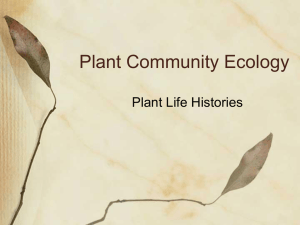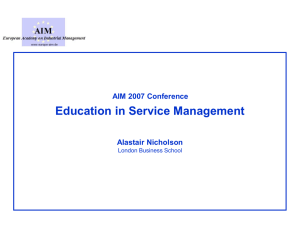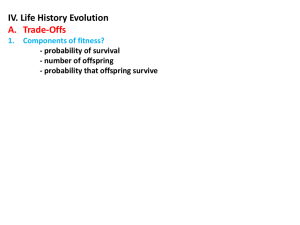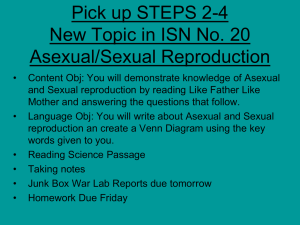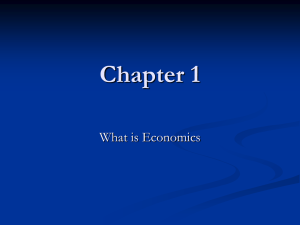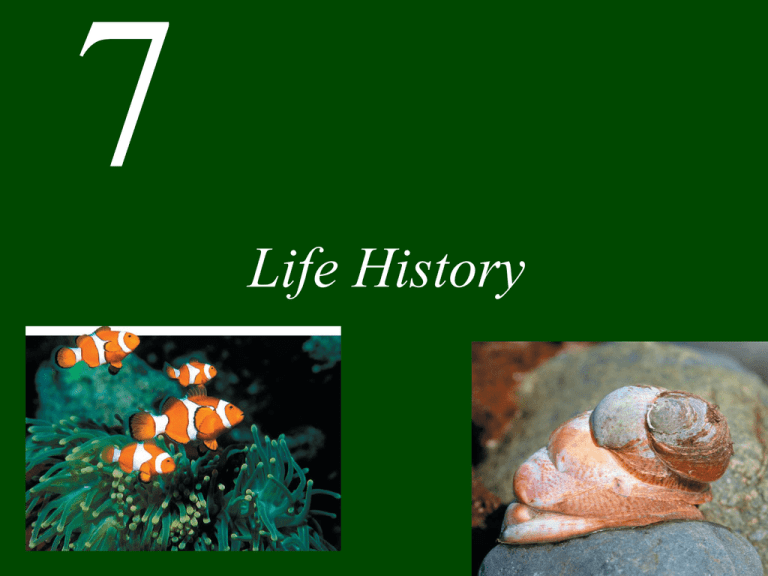
7
Life History
Chapter 7 Life History
CONCEPT 7.1 Life history patterns vary
within and among species.
CONCEPT 7.2 Reproductive patterns can
be classified along several continua.
CONCEPT 7.3 There are trade-offs between
life history traits.
CONCEPT 7.4 Organisms face different
selection pressures at different life cycle
stages.
Introduction
An organism’s life history is a record of
events relating to its growth,
development, reproduction, and survival.
Life history characteristics include:
• Age and size at sexual maturity
• Amount and timing of reproduction
• Survival and mortality rates
Concept 7.1
Life history patterns vary within and among
species.
Concept 7.1
Life History Diversity
The life history strategy of a species is
the overall pattern in average timing
and nature of life history events.
It is shaped by the way the organism
divides its time and energy between
growth, reproduction, and survival.
Such differences result from genetic
variation, differences in environmental
conditions, or both.
Figure 7.3 Life History Strategy
Concept 7.1
Life History Diversity
Some life history traits are determined
genetically.
Ideal or optimal life histories maximize
fitness (genetic contribution to future
generations).
But none are perfect; all organisms face
constraints and ecological trade-offs.
Concept 7.1
Life History Diversity
Phenotypic plasticity: One genotype
produces different phenotypes under
different environmental conditions.
For example, growth and development
may be faster in higher temperatures.
Changes in life history traits can cause
change in adult morphology.
Figure 7.4 Plasticity of Growth Form in Ponderosa Pines
Concept 7.1
Life History Diversity
Phenotypic plasticity may result in a
continuous range of sizes; or discrete
types called morphs.
Spadefoot toad tadpoles have small
omnivore morphs and larger carnivore
morphs.
Allometry: Different body parts grow at
different rates, resulting in differences
in shape or proportion.
Figure 7.5 Phenotypic Plasticity in Spadefoot Toad Tadpoles
Concept 7.1
Life History Diversity
Modes of Reproduction
Asexual reproduction: Simple cell
division (binary fission)—all
prokaryotes and many protists.
Some multicellular organisms reproduce
both sexually and asexually (e.g.,
corals). Most plants and animals and
many fungi and protists reproduce
sexually.
Figure 7.6 Life Cycle of a Coral
Concept 7.1
Life History Diversity
Isogamy: Gametes are equal in size.
Organisms such as the green alga
Chlamydomonas reinhardii have two
mating types that produce isogametes.
Anisogamy: Gametes of different sizes.
Usually the egg is much larger and
contains nutritional material.
Most multicellular organism produce
anisogametes.
Figure 7.7 Isogamy and Anisogamy
Concept 7.1
Life History Diversity
Sexual reproduction has disadvantages:
• An individual transmits only half of its
genome to the next generation.
• Population growth rate is only half
that of asexually reproducing
species.
• Recombination and chromosome
assortment during meiosis can break
up favorable gene combinations.
Figure 7.8 The Cost of Sex
Concept 7.1
Life History Diversity
Benefits of sexual reproduction:
Recombination promotes genetic
variation and increased ability of
populations to respond to
environmental challenges.
A test of this idea using the nematode
worm Caenorhabditis elegans was
done by Morran et al. (2011).
Figure 7.9 Benefits of Sex in a Challenging Environment
Concept 7.1
Life History Diversity
Complex life cycles have at least two
stages that have different body forms
and live in different habitats and eat
different foods.
Metamorphosis: Abrupt transition in form
between the larval and juvenile stages.
Most vertebrates have simple life cycles.
Complex life cycles are common in
insects, marine invertebrates,
amphibians, and some fishes.
Figure 7.10 The Pervasiveness of Complex Life Cycles
Concept 7.1
Life History Diversity
Some species have direct
development—the fertilized egg
develops into a juvenile without passing
through a larval stage.
Many parasites have evolved complex
life cycles with specialized stages for
each host.
Figure 1.3 The Life Cycle of Ribeiroia
Concept 7.1
Life History Diversity
Many plants, algae, and protists also
have complex life cycles.
Plants and most algae have alternation
of generations in which a multicellular
diploid sporophyte alternates with a
multicellular haploid gametophyte.
Figure 7.11 Alternation of Generations in a Fern
Concept 7.2
Reproductive patterns can be classified
along several continua.
Concept 7.2
Life History Continua
Number of reproductive events during
the organism’s lifetime:
Semelparous species reproduce only
once.
Iteroparous species can reproduce
multiple times.
Concept 7.2
Life History Continua
Semelparous species include annual
plants.
Agave—vegetative growth can last up to
25 years; also produces clones
asexually.
Giant Pacific octopus—female lays one
clutch of eggs and broods them for six
months, dying after they hatch.
Figure 7.12 Agave: A Semelparous Plant?
Concept 7.2
Life History Continua
Iteroparous species include:
• Trees such as pines and spruces
• Most large mammals
Concept 7.2
Life History Continua
r-selection and K-selection describe
two ends of a reproductive strategy
continuum.
r is the intrinsic rate of increase of a
population.
r-selection: Selection for high population
growth rates; an advantage in newly
disturbed habitats and uncrowded
condition.
Concept 7.2
Life History Continua
K is the carrying capacity for a
population.
K-selection: Selection for lower growth
rates in populations that are at or near
K; an advantage in crowded conditions;
efficient reproduction is favored.
Concept 7.2
Life History Continua
r-selected (“live fast, die young”):
• Short life spans, rapid development,
early maturation, low parental
investment, high reproduction rates
• Most insects, small vertebrates such
as mice, weedy plant species
Concept 7.2
Life History Continua
K-selected (“slow and steady”):
• Long-lived, develop slowly, late
maturation, invest heavily in each
offspring, low reproduction rates
• Large mammals, reptiles such as
tortoises and crocodiles, and longlived plants such as oak and maple
trees
Concept 7.2
Life History Continua
Most life histories are intermediate
between these extremes.
Braby (2002) compared three Australian
butterfly species. The one in drier, less
predictable habitats had more rselected characteristics.
The two species found in more
predictable wet forest habitats had Kselected characteristics.
Concept 7.2
Life History Continua
One classification scheme for plant life
histories is based on stress and
disturbance (Grime 1977).
Stress—any abiotic factor that limits
growth.
Disturbance—any process that
destroys plant biomass.
Concept 7.2
Life History Continua
Four habitat types possible:
• Low stress, low disturbance
• High stress, low disturbance
• Low stress, high disturbance
• High stress, high disturbance—not
suitable for plant growth
Figure 7.13 Grime’s Triangular Model
Concept 7.2
Life History Continua
Charnov proposed a scheme that
removes the influence of size and time.
For example, age of maturity is positively
correlated with life span in many
species.
To remove effect of lifespan, divide a
species’ average age of maturity by its
average life span to get a
dimensionless ratio (c).
Figure 7.14 A Dimensionless Life History Analysis
Concept 7.2
Life History Continua
Dimensionless ratios allow comparisons
of very different life histories.
c differs between ectothermic and
endothermic animals: it takes fish and
lizards longer to mature than mammals
and birds.
Concept 7.2
Life History Continua
Charnov’s scheme may be most useful
when comparing life histories across a
range of taxonomy or size.
Grime’s scheme may be best for
comparing plant taxa.
The r–K continuum is useful in relating
life histories to population growth
characteristics.
Concept 7.3
There are trade-offs between life history
traits.
Concept 7.3
Trade-Offs
Trade-offs: Organisms allocate limited energy
or resources to one function at the expense of
another.
Size and number of offspring:
• More investment in each individual
offspring, fewer offspring can be produced.
• Investments: Energy, resources, time and
loss of chances for other activities such as
foraging.
Concept 7.3
Trade-Offs
Lack clutch size: Maximum number of
offspring a parent can successfully
raise to maturity.
Named for David Lack (1947) who
noticed that bird’s clutch size increases
with latitude; longer daylight hours may
allow parents more time to forage and
feed more offspring.
Figure 7.15 Clutch Size and Survival
Concept 7.3
Trade-Offs
In species without parental care,
resources are invested in propagules
(eggs or seeds).
Size of the propagule is a trade-off with
the number produced.
In plants, seed size is negatively
correlated with the number of seeds
produced.
Figure 7.16 Seed Size–Seed Number Trade-Offs in Plants
Concept 7.3
Trade-Offs
The size–number trade-off can also
occur within species.
Northern populations of western fence
lizards have larger average clutch size,
but smaller eggs, than southern
populations.
Figure 7.17 Egg Size–Egg Number Trade-Off in Fence Lizards
Concept 7.3
Trade-Offs
Allocating resources to reproduction can
decrease an individual’s growth rate,
survival rate, or potential for future
reproduction.
Male fruit flies spend more time and
energy courting unmated females than
recently mated females.
Figure 7.18 Trade-Offs between Reproduction and Survival (Part 2)
Concept 7.3
Trade-Offs
Similar trade-offs have been observed in
mollusks, insects, mammals (including
humans), fishes, amphibians, reptiles,
and plants.
By allocating resources to reproduction
instead of growth, an individual will
reproduce at a smaller size, with fewer
offspring. This might decrease an
individual’s potential for future
reproduction.
Concept 7.4
Organisms face different selection
pressures at different life cycle stages.
Concept 7.4
Life Cycle Evolution
As selection pressures change, different
morphologies and behaviors are
adaptive at different life cycle stages.
Concept 7.4
Life Cycle Evolution
Small size has benefits and drawbacks.
Small early life stages can be vulnerable
to predation and competition for food.
But small size can allow early stages to
do things that adult stages cannot.
Organisms have various mechanisms to
protect the small life stages.
Concept 7.4
Life Cycle Evolution
Parental Investment:
• Provisioning eggs or embryos—yolk
and protective coverings for eggs,
nutrient-rich endosperm in plant
seeds
• Parental care—invest time and
energy to feed and protect offspring
Figure 7.20 Kiwi Parental Investment
Concept 7.4
Life Cycle Evolution
Dispersal and Dormancy:
• Small offspring are well-suited for
dispersal
• Dispersal can reduce competition
among close relatives and allow
colonization of new areas
• Dispersal can allow escape from
areas with diseases or high
predation
Concept 7.4
Life Cycle Evolution
Dispersal ability has evolutionary
significance.
Hansen (1978) found that fossil marine
snail species with swimming larvae had
larger geographic ranges and tended to
go extinct less than species that
developed directly into crawling
juveniles.
Figure 7.21 Developmental Mode and Species Longevity
Concept 7.4
Life Cycle Evolution
Dormancy: State of suspended growth
and development in which an organism
can survive unfavorable conditions.
Small seeds, spores, eggs, and embryos
are best suited to dormancy—less
metabolic energy is needed to stay
alive.
But some larger animals also enter
dormancy.
Concept 7.4
Life Cycle Evolution
Complex life cycles may result from
stage-specific selection pressures and
help minimize the drawbacks of small,
vulnerable early stages.
Separate life history stages can evolve
independently in response to size- and
habitat-specific selection pressures.
Concept 7.4
Life Cycle Evolution
Functional specialization of stages is a
common feature of complex life cycles.
In many insects the larval stage stays in
a small area, such as on a single plant.
The larvae are specialized for feeding
and growth. The adult is specialized for
dispersal and reproduction.
Concept 7.4
Life Cycle Evolution
In marine invertebrates, larvae are
specialized for both feeding and
dispersal in ocean currents.
Many larvae have specialized ciliated
bands for feeding, covering most of the
body.
They may also have spines, bristles, or
other structures to deter predators.
Figure 7.22 Specialized Defensive Structures in Marin Invertebrate Larvae
Concept 7.4
Life Cycle Evolution
Even in species with gradual
morphological change, individuals may
have different ecological roles
depending on size and age—niche
shift.
Ecological niche: The physical and
biological conditions that an organism
needs to grow, survive, and reproduce.
Concept 7.4
Life Cycle Evolution
If the larval habitat is very favorable,
metamorphosis may be delayed or
eliminated.
Some salamanders mature sexually while
retaining larval morphology and habitat
(paedomorphic).
Figure 7.23 Paedomorphosis in Salamanders
A Case Study Revisited: Nemo Grows Up
Sequential hemaphroditism: Changes
in sex during the course of the life
cycle.
Common in fish and invertebrates.
The timing should take advantage of
high reproductive potential of different
sexes at different sizes.
Figure 7.24 Sequential Hermaphroditism
Connections in Nature: Territoriality, Competition, and Life History
“Settlement lotteries” also affect other
species that compete for space.
Trees in tropical rain forests compete for
space and sunlight.
Success of a seedling may depend on
chance events, such as death of a
nearby tree that creates a gap in the
canopy.







